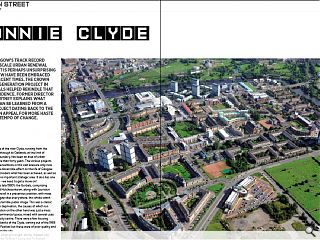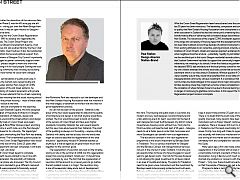Crown Street: Bonnie Clyde
23 Jan 2023
With Glasgow’s track record of large-scale urban renewal projects it is perhaps unsurprising that so few have been embraced in more recent times. The Crown Street regeneration project in the Gorbals helped rekindle that lost confidence. Former director Tom Macartney explains what lessons can be learned from a grand project dating back to the 1990s, in an appeal for more haste to up the tempo of change.
On the south side of the river Clyde, running from the Kingston Bridge through to Oatlands, at the limit of Glasgow’s city boundary, has been an area of urban transition for more than forty years. The various projects and countless interventions in this vast area are only now starting to have a discernible effect on the life of Glasgow and this article considers what has been achieved, as well as what hasn’t for this important strategic area. It also has one overarching plea - we need to get a move on! As far back as late 1980’s the Gorbals, comprising Crown Street and Hutchesontown, along with Lauriston and Oatlands were all in a precarious position, with mass demolitions and gap sites everywhere, this whole swath of Glasgow had a terrible public image.
This was a classic example of urban deprivation, the causes of which run very deep. Tradeston on the other hand was just a mess of poor-quality commercial space, mixed with several uses unwanted in the city centre. There were a few housing initiatives on the banks of the Clyde, coming out of the 1988 Glasgow Garden Festival but these were of poor quality and disconnected from the city. The post war vision of a bright, shinny, modern city district proposed by Sir Basil Spence and Sir Robert Matthew was long gone and perhaps the most controversial area that was left after the demolition of the notorious flats of Hutchesontown Phase E, was the 40-acre gap site left by this demolition - sitting just over the Albert Bridge from Glasgow City centre.
It was an open wound on Glasgow – something had to be done. That something was the Crown Street Regeneration Project, set up in 1990 to develop and regenerate the 40-acre vacant site. The Crown Street Project was established by the Glasgow Development Agency, (now Scottish Enterprise) and was pushed hard by the then Chief Executive of the GDA, Stuart Gulliver. It also had substantial backing from Scottish Homes and political support from local elected members of Glasgow City Council. Importantly the project managed to garner community support when the regeneration process began to work and show that there was something in it for local people. Gaining the trust of a long-suffering community was not easy, but building almost 30% of all new homes for social rent changed perceptions.
Crown Street set standards of quality and scale. It changed the way the Gorbals was viewed locally and nationally. The master planner Piers Gough of CZWG wanted the recreation of the old street patterns, he proposed the building of modern tenements with private back courts and he was adamant that on-street carparking would work. He also insisting that the social housing should not be inferior to the private housing – most of these ideas were considered radical at the time. Crown Street also set a template for the adjoining Masterplan of Queen Elizabeth Square; this time designed by Gerry Henaughen of Hypostyle Architects in Glasgow. Again very high standards of materials, design and construction were used and the street patterns and design codes successfully tried on Crown Street were again adopted. The Page & Park/Miller Homes project encircling the St Francis Centre is worth note, as is the Piers Gough/Cruden Homes phase for its virtuosity.
The Hypostyle/Dawn Homes project overlooking the Rose Park has already been an award winner. The fundamental question posed at the beginning of the Crown Street Regeneration was would the project stand the test of time. Some 25 years after much of the development has been completed, it still looks great and works well. Job done! As the bulk of Crown Street began to complete and Queen Elizabeth Square started to rise in line with the Hypostyle masterplan, the possibility of Oatlands becoming a further phase was discussed. The City Council for their own reasons decided to go a different route and although the GDA were prepared to financially support the regeneration of Oatlands the Council decided that they would do it all themselves. They organised a design competition and after some little controversy as regards who had won, they finally appointed Bett Homes. The fact that Richmond Park was reduced to suit the developer and that New Gorbals Housing Association were not involved in the initial stages, is testament to the fact that this was not good regeneration practice. As can now be seen on the ground - Oatlands is the lesser of the four areas regenerated to date and the quality of architecture and design is not what anyone would have wished.
The trick would have been to build on the basis of the success of Crown Street and have even higher standards. Incredibly Oatlands has won several awards, but this says more about awards than Oatlands. The proof of the pudding as always is in the eating – anyone visiting Oatlands will clearly see that at best, the two words that might be used to describe the regeneration of this area would be - opportunity missed! If Oatlands teaches us anything it is that all agencies of government must work together for the common good. The regeneration of Lauriston was next on the timeline, staring on site in the summer of 2008, but this regeneration project has one big problem. Simply put - It should have been complete by now. The fact that the regeneration of Lauriston still has around six or seven years to go, before the last resident moves in is tragic.
The Lauriston story is one of bureaucratic delay and a lack of development ambition. Lauriston has been taken forward by Urban Union in partnership with New Gorbals Housing Association. Fraser Stewart the director of NGHA has cajoled, pushed and argued to try and make progress – It shouldn’t be this hard. The housing and public areas in Lauriston are modern and very well designed. Good architecture and urban planning are at its heart. Lauriston has the feel of well-designed and well-built European city district where mixed tenure housing works without fuss. From start to finish Lauriston will take the best part of 25 years – Glasgow needs to set a faster pace in order that more areas and more Glaswegians can benefit from true regeneration. The last area to consider in this vast regeneration programme is the recent investment by Barclays Bank in Tradeston.
This is a serious investment for Glasgow and the Barclays Campus will change financial services not just in the city but in wider Scotland. It will also give job opportunities to those who have struggled in recent years to get decent work - the trick for the area however is not allowing this great investment to sit like an island in an area of muddle and decay. The plans for Tradeston need to be given a new momentum and the investment by Barclays needs to be properly protected and built upon. Delivery, not brave words, is what is required and a focused delivery team similar to that established for The Crown Street Regeneration Project is one possible way forward. Tradeston could be the next big thing for Glasgow - let’s hope it doesn’t take another 25 years to complete.
There is no doubt that the south side of the Clyde has greatly improved, many lessons have been learned and individuals such as Fraser Stewart continue to push for excellence. There is however still much to do particularly in Tradeston, but this leads inextricably to the two main issues. Firstly, how long will it take to regenerate Tradeston and secondly will there be a mechanism for controlling and driving all the smaller add on developments that will ultimately form and complete this vast area to the south of the Clyde. Many years ago, a film was made comparing Glasgow’s regeneration in the Gorbals with an area in Chicago and in a memorable moment a resident of New Gorbals Housing Association, living in Benny Lynch Court was asked if she had any problems or concerns with the Crown Street Project – “only one, there should be twenty Crown Streets so that the people of Glasgow can get a decent home” Progress to date in terms of quality has mostly been good, but it has taken far too long. We have let the people of Glasgow down. We could have built 20 Crown Streets in the time we have taken – now what would that have done to the city!




